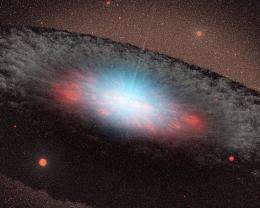Taking the pulse of a supermassive black hole

(Phys.org) —Rare heartbeat-like pulsations detected from a supermassive black hole may grant scientists better insight into these exotic objects, according to two University of Alabama astronomers who co-authored a recent scientific article on the discovery.
Drs. Dacheng Lin, a post-doctoral researcher, and Jimmy Irwin, an assistant professor in UA's physics and astronomy department, co-wrote, along with three French scientists, an article about this black hole, with a mass about 100,000 times that of the sun, that published in a recent issue of Astrophysical Journal Letters.
"Such signals from supermassive black holes are very important for understanding the link between black holes across mass scale, but they have proved very difficult to find," Lin said. "Only two cases were discovered before, and our signal is five times stronger than those two cases."
The scientists used data provided by the European Space Agency's XMM-Newton space observatory in their analysis. This black hole is 1.7 billion light years away from Earth at the center of a distant galaxy, the UA scientists said.
The black hole, at the time of observation, was "eating" matter at near the maximum rate, Lin said. The UA scientists have requested additional observation time by XMM-Newton in an attempt to better understand why this black hole is eating so much matter.
"One interesting possibility is a nearby star happened to be wandering too closely to the black hole," Lin said, "so the star is torn apart by the black hole and a lot of gas becomes available to fall onto the black hole."
The origin of the pulsation, or "quasi-periodic X-ray oscillation" as scientists refer to it, is difficult to identify, Lin said. One explanation is that as the matter falls toward the black hole, a flattened disk forms. The disk produces high-energy X-rays. As the disc structure changes cyclically due to eating so much matter, so does the intensity of the X-rays streaming from it.
"Such oscillations are common in black holes with masses less than 20 times that of the sun, but are rarely seen in supermassive black holes," Lin said. "Black holes are one of the most exotic objects in the universe, and it is so compact and the gravity around it so strong that many interesting physical phenomena, such as the heartbeat-like X-ray signal discovered here, can happen."
The discovery published in the Oct. 10 edition.
Journal information: Astrophysical Journal Letters
Provided by University of Alabama in Tuscaloosa




















